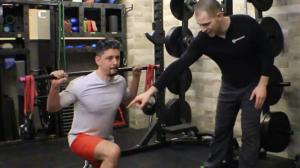
The Brookbush Institute Announces an Evidence-based Course on Stability Training
A comprehensive systematic research review was used to develop evidence-based progressions and regressions for all large movement patterns (muscle groups).
A stability training program prioritizes exercise progression over increasing repetitions, sets, load, or speed. For example, progressing from a plank to a plank on a stability ball increases the stability challenge. Reducing the base of support during this exercise from two feet on the ground to a single foot would be an additional stability progression.
Introduction:
This course discusses stability training, including core stability training, upper body stability training, lower body stability training, balance training, injury prevention, and the use of stability training in physical rehabilitation. A comprehensive systematic research review was used to develop evidence-based progressions and regressions for all large movement patterns (muscle groups), including the use of unstable loads and environments. Additionally, stability training outcomes and adaptations are discussed in detail: EMG activity, motor pattern recruitment, fatigue, rate of force development, balance, muscle endurance, muscle strength, muscle hypertrophy (muscle growth), sports performance, injury prevention, and injury recovery.
Research Review Findings:
Some findings from the included systematic review resulted in counter-intuitive, or at least less conventional recommendations. For example, there are a few studies that suggest unstable environments (e.g. core stability exercises on a Bosu Ball) may exaggerate altered recruitment patterns in those exhibiting dysfunction. This may imply that corrective exercise (e.g. serratus anterior activation) should precede multi-joint stability exercises. Additionally, research suggests that unstable loads result in larger changes in EMG activity than unstable surfaces/environments. This may imply that slosh pipes, sandbags, hanging/swinging loads, etc., should be considered more often and perhaps be prioritized over unstable environments like foam pads, Bosu balls, and balance boards.
Movement professionals (personal trainers, fitness instructors, physical therapists, athletic trainers, massage therapists, chiropractors, occupational therapists, etc.) should consider stability training a pillar of performance, injury prevention, and rehabilitation programming, and the recommendation of progressions and regressions based on stability, an essential skill. This course is part of our continued effort to optimize, evidence-based “exercise program design” recommendations.
This Course Includes:
- Study Guide
- Test and Illustrations
- Audio Voice-over
- Research Review
- Technique Videos
- Case Study and Sample Routine
- Practice Exam
- 3 Credit Final Exam
Check out the full course for more: Stability Training
Brent D Brookbush
Brookbush Institute
+1 2012069665
email us here
Visit us on social media:
Facebook
Twitter
LinkedIn
Instagram
YouTube
TikTok
EIN Presswire does not exercise editorial control over third-party content provided, uploaded, published, or distributed by users of EIN Presswire. We are a distributor, not a publisher, of 3rd party content. Such content may contain the views, opinions, statements, offers, and other material of the respective users, suppliers, participants, or authors.


